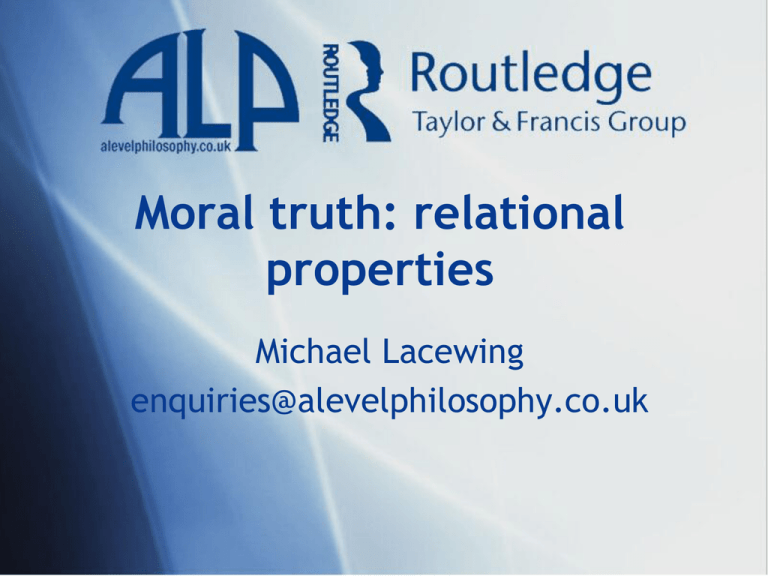Moral truth: relational properties
advertisement

Moral truth: relational properties Michael Lacewing enquiries@alevelphilosophy.co.uk The ‘is-ought gap’ • (Natural) facts do not entail moral judgments: – Hume: ‘this ought…expresses some new relation [of which it] seems altogether inconceivable, how this new relation can be a deduction from others, which are entirely different from it’. • Explanation: morality is not a matter of fact, but of attitude Emotivism and disagreement • A J Ayer: when two people disagree over a fact, the matter can be resolved (or at least, we know what would resolve it); when two people disagree over a value judgment, either they disagree over a (natural) fact, or there is no further way to resolve the disagreement. • Moral judgments express feelings of approval/disapproval. Moral reasoning • But when justifying a moral claim… – E.g. Eating meat is wrong • …we appeal to natural facts – E.g. Animals suffer. • Moral reason: a reason for someone to do something – E.g. That animals suffer is a reason for you to not eat meat. • That some fact is a moral reason is a relational property. Moral truth • Whether some fact is a reason is objectively true or false. – Epistemic reasons: Radiometric decay indicates that the some dinosaur bones are 65 million years old. This is (objectively) a reason to believe that dinosaurs lived on Earth 65 million years ago. • Facts about reasons are normative facts. Moral truth • To say that something is wrong is to say that the moral reasons against doing it are stronger than any moral reason in favour of doing it. • The judgment, ‘x is wrong’, is objectively true or false. • Hume is right that natural facts do not establish moral truths. We must also consider the normative facts. Are moral reasons objective? • How can something that is relational be objective? – Many facts depend on us and how we are, e.g. whether a piece of music is baroque or classical. – Aristotle: There are also facts about what we need in order to flourish. • But moral reasons are relative to individuals – whether the fact that animals suffer is a reason for me not to eat meat depends on whether I care Two views of attitudes • Blackburn: our judgments about what reasons we have are a reflection of our attitudes, not a description of independent normative facts. • Scanlon: our attitudes are reflections of our judgments about reasons, they are ‘judgment-sensitive’. Primary and secondary qualities • Primary qualities: properties of an object that are not related by definition to perceivers, e.g. size, mass, and shape (scientific account of the world) • Secondary qualities: properties that are related to perceivers, e.g. colour and smell (commonsense account) • Hume: secondary qualities are ‘minddependent’ The analogy with secondary qualities • Hume: ‘when you pronounce any action or character to be vicious, you mean nothing, but that… you have a feeling… of blame from the contemplation of it. Vice and virtue, therefore, may be compar’d to sounds, colours, heat and cold, which… are not qualities in objects, but perceptions in the mind’ • Moral judgments (and talk about moral reasons) are, ultimately, expressions of our feelings and what we care about A cognitivist response • McDowell: secondary qualities are properties of the object that enable it to cause certain experiences in us. – Colour is relational, but objective: To be brown is to look brown to normal perceivers under normal conditions. • Moral judgments are relative to human responses, but are not subjective.






